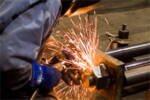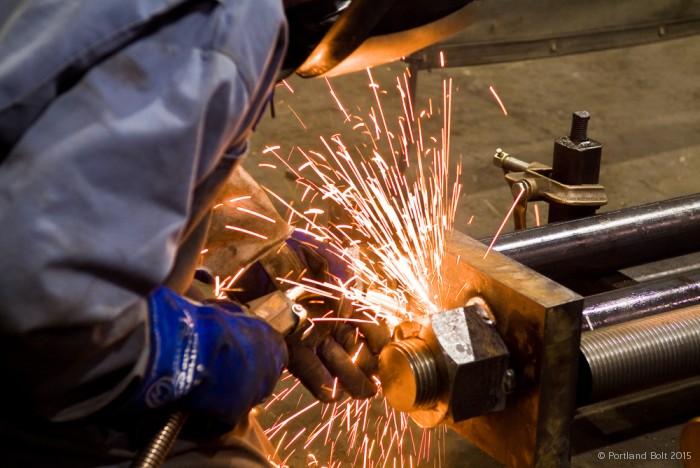 Many grades of bolt gain their strength though a heat treating process, and the addition of heat during welding can adversely alter those strength properties. However, some lower strength grades are easily weldable when manufactured from weldable steel.
Many grades of bolt gain their strength though a heat treating process, and the addition of heat during welding can adversely alter those strength properties. However, some lower strength grades are easily weldable when manufactured from weldable steel.
In general, steel items which have been heat treated for strength should generally not be welded since welding inevitably heats the items past the tempering point, resulting in a loss of strength in the heated area and other more unpredictable effects like cracking. Whether a particular weld would have noticeably detrimental effects is largely a matter of engineering judgment; some engineers are comfortable with a small tack weld in certain applications, while others are not.
AISC Design Guide 21 has this to say about welding to bolts and nuts in general,
“Occasionally, it becomes desirable to weld bolts to structural steel, or bolts to nuts. As a general principle, welding should not be done on bolts or nuts. However, if essential, the composition of the bolt (and nuts if involved) must be carefully considered.”
So the position the American Institute of Steel Construction takes is that whenever possible, welding to bolts and nuts should be avoided, however there are times when it is necessitated. In those cases special care should be taken to assure that the bolt grades being welded are made from weldable steel and will not be detrimentally affected by the addition of heat.
Additionally, the AISC Design Guide 21 breaks down by grade several common bolts and makes welding recommendations for each.
| ASTM Standard | Recommendations per AISC Design Guide 21 |
|---|---|
| A307, Grades A, B, C | If Supplemental requirement S1 is called out, then bolt should be weldable. If not, weldability is uncertain and should be investigated. |
| A325 | Not recommended |
| A354, Grades BC & BD | Not recommended |
| A449 | Not recommended |
| A490 | Always prohibited |
| F1554 Grade 36 | Should be weldable, but chemical composition should be investigated to make sure. |
| F1554 Grade 55 | If Supplemental requirement S1 is called out, the bolt should be weldable. If not, weldability is uncertain and should be investigated. |
| F1554 Grade 105 | Not recommended |
| Nuts & Washers | Can be problematic |
In summary, caution should be used when welding to any bolts or nuts. If care has been taken to assure that the fasteners were ordered and manufactured to be weldable, then you can be reasonably certain of their weldability. If not, then the material composition should be investigated and an engineer or metallurgist should be consulted to assure that any addition of heat will not adversely affect the fastener.

No way. Will crack every time. The material becomes as fragile as glass.
Can you weld 304l bolt up stud to stainless 304 flange ?
@Jake- 304 stainless is generally weldable, however there may be times where it may not be advisable to do so. You will need to contact the project engineer to determine if you can weld in this case.
What about A193 Gr, B7, Is welded or not?
@Abdulrahman- B7 is not normally a weldable material. It derives its strength through heat treating, so the addition of heat during welding can adversely affect the mechanical properties.
A354 BD / A490 Bolts, are they weldable ?
@Ed- No, A354 and A490 bolts are not weldable. First, both get their high strength from a heat treating process, so if heat is added (as during welding), it will adversely affect the mechanical properties of the bolt. Second, both are made from alloy steel, which does not have chemical make up to considered weldable by normal standards.
pl let me know about any paint or paste available for utilizing as a substitute of welding of Nut and bolts
@R K – I am sorry, but we do not have any information regarding paint or paste in place of welding, we have not come across that before.